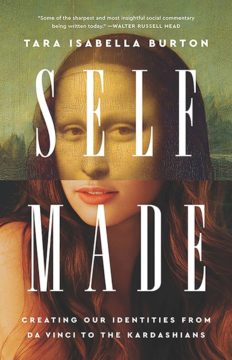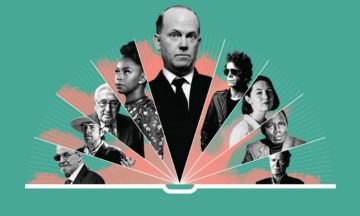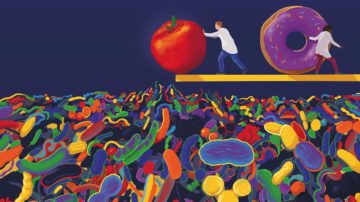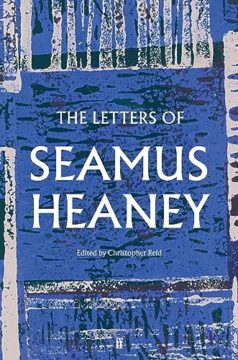Category: Recommended Reading
Have We Become Gods?
Brad East at Commonweal:
 I am what I want, and I have the power within myself to make myself what I want to be, if only I find the will to activate this inner potential—or rather, to manifest this authentic identity. Such is the thesis under review in Tara Isabella Burton’s new book, Self-Made: Creating Our Identities from Da Vinci to the Kardashians. The thesis is not a new one. It has a long history, which, in Burton’s telling, begins around the fifteenth century. Though she finds its philosophical culmination in the eighteenth, with the Enlightenment, most of her story covers the past two hundred years: from bon ton and Beau Brummell to “the two most prominent self-creators of the past twenty years,” Kim Kardashian and Donald Trump. Across Western Europe and the Anglophone world, self-creation as both a transcendent possibility and a moral imperative trickles down to ordinary people’s lives and self-understanding, mutating in tandem with religious, economic, and technological changes. Since creation is traditionally the prerogative of deity, Burton’s story is ultimately about “how we became gods.”
I am what I want, and I have the power within myself to make myself what I want to be, if only I find the will to activate this inner potential—or rather, to manifest this authentic identity. Such is the thesis under review in Tara Isabella Burton’s new book, Self-Made: Creating Our Identities from Da Vinci to the Kardashians. The thesis is not a new one. It has a long history, which, in Burton’s telling, begins around the fifteenth century. Though she finds its philosophical culmination in the eighteenth, with the Enlightenment, most of her story covers the past two hundred years: from bon ton and Beau Brummell to “the two most prominent self-creators of the past twenty years,” Kim Kardashian and Donald Trump. Across Western Europe and the Anglophone world, self-creation as both a transcendent possibility and a moral imperative trickles down to ordinary people’s lives and self-understanding, mutating in tandem with religious, economic, and technological changes. Since creation is traditionally the prerogative of deity, Burton’s story is ultimately about “how we became gods.”
more here.
Tara Isabella Burton — Self-Made: Creating Our Identities from Da Vinci to the Kardashians
Teetering Canaries
Judith Schalansky at The Paris Review:
 One stifling hot night in early August, I dreamed, as I always do when I have a fever, the old, familiar dream: the earth opens up before my feet, a gaping pit appears, and into this pit I fall, then clamber straight back out, as eager as a cartoon character, only to fall into the next pit that suddenly yawns before me. An endless obstacle course engineered by some higher power, an experiment going nowhere, the opposite of a story. This dream has followed me since childhood and is probably as old as the realization that I will, one day, end up in a pit forever. As a piece of drama, it is extremely simple, and yet it’s an effective dream and no more unoriginal than that of my friend Sibylle, who told me over breakfast a few days later that she has regular nightmares of being swept away by a vast, tsunami-like wave.
One stifling hot night in early August, I dreamed, as I always do when I have a fever, the old, familiar dream: the earth opens up before my feet, a gaping pit appears, and into this pit I fall, then clamber straight back out, as eager as a cartoon character, only to fall into the next pit that suddenly yawns before me. An endless obstacle course engineered by some higher power, an experiment going nowhere, the opposite of a story. This dream has followed me since childhood and is probably as old as the realization that I will, one day, end up in a pit forever. As a piece of drama, it is extremely simple, and yet it’s an effective dream and no more unoriginal than that of my friend Sibylle, who told me over breakfast a few days later that she has regular nightmares of being swept away by a vast, tsunami-like wave.
I was reminded that of all the arts I would like to master, lucid dreaming is at the top of the list: you sleep and dream, fully aware that you are asleep and dreaming, but the real skill lies in being able to intervene in the events of your dream and steer the plot in your favor.
more here.
“Theory of Mind,” meet Henry James
John Horgan in Nautilus:
 Science journalism is really about everything, I like telling my science-journalism students, because science is really about everything. Take The Golden Bowl, the insanely prolix novel by Henry James, which I read as penance after zipping through a Stephen King gore-fest. The Golden Bowl, I’d heard, is a slog compared to thrillers like The Portrait of a Lady and Turn of the Screw, but James called Bowl his “solidest” novel. By that he must have meant the most Jamesian because The Golden Bowl reads like a parody of James. H.G. Wells’ comparison of James to a hippopotamus trying to pick up a pea comes to mind.
Science journalism is really about everything, I like telling my science-journalism students, because science is really about everything. Take The Golden Bowl, the insanely prolix novel by Henry James, which I read as penance after zipping through a Stephen King gore-fest. The Golden Bowl, I’d heard, is a slog compared to thrillers like The Portrait of a Lady and Turn of the Screw, but James called Bowl his “solidest” novel. By that he must have meant the most Jamesian because The Golden Bowl reads like a parody of James. H.G. Wells’ comparison of James to a hippopotamus trying to pick up a pea comes to mind.
Almost nothing happens, and yet nothing is straightforward, certainly not the prose. James jams sentences with subjunctives and conditionals, second and third thoughts, double and triple negatives. Just once, I whined, I wish you’d say what you mean. Plus, the characters are socialites who would never dream of washing their own dishes. But the book grew on me. Superficially dated, it is actually bracingly modern, or timeless. It dwells on what psychologists call “theory of mind,” our supposedly innate ability to infer each other’s thoughts. James is telling us, in effect: You think you know what’s going on in other peoples’ heads? Think again.
More here.
Tuesday Poem
Lamb
Saw a lamb being born.
Saw the shepherd chase and grab a big ewe
and dump her on her side.
Saw him rub some stuff from a bottle on his hands.
Saw him bend and reach in.
Heard two cries from the ewe.
Two sharp quick cries. Like high grunts.
Saw him pull out a slack white package.
Saw him lay it out on the ground.
Saw him kneel and take his teeth to the cord.
Saw him slap the package around.
Saw it not move.
Saw him bend and put his mouth to it and blow.
Doing this calmly, half kneeling.
Saw him slap it around some more.
Saw my mother watching this. Saw Angela. Saw Peter.
Saw Mimi, with a baby in her belly.
Saw them standing in a row
by the dry stone wall, in the wind.
Saw the package move.
Saw it was stained with red and yellow.
Saw the shepherd wipe red hands on the ewe’s wool.
Heard the other sheep in the meadow calling out.
Saw the package shaking its head.
Saw it try to stand. Saw it nearly succeed.
Saw it have to sit and think about it a bit.
Saw a new creature’s first moment of thinking.
Felt the chill blowing through me.
Heard the shepherd say:
“Good day for lambing. Wind dries them out.”
Saw the package start to stand. Get half-way. Kneeling.
Saw it push upward. Stagger, push. And make it.
Stand and standing.
Saw it surely was a lamb, a lamb, a lamb.
Saw a lamb being born!
by Michael Dennis Browne
from News of the Universe
Sierra Club Books, 1980
Who should pay for open-access publishing?
Katharine Sanderson in Nature:
 In April, the entire editorial boards of two companion neuroimaging journals resigned. The 42 researchers were protesting against what they thought to be excessive article-processing charges (APCs) for authors publishing in the journals, which are run by Dutch publishing giant Elsevier. The APC for NeuroImage is US$3,450, and its sister journal NeuroImage: Reports has doubled its APC to $1,800.
In April, the entire editorial boards of two companion neuroimaging journals resigned. The 42 researchers were protesting against what they thought to be excessive article-processing charges (APCs) for authors publishing in the journals, which are run by Dutch publishing giant Elsevier. The APC for NeuroImage is US$3,450, and its sister journal NeuroImage: Reports has doubled its APC to $1,800.
APCs have become an integral part of the revolution in scientific publishing known as open access — the system in which papers are freely available for all to read after publication. Journals such as NeuroImage and thousands of others charge authors APCs to cover publishing costs, such as administration, editing and typesetting. In return, when these papers are published, they are immediately accessible to all. The fees can range from less than $1,000 to more than $10,000 per paper. In some cases authors don’t pay them directly, if their institutions have entered into contracts with publishers that cover the costs of open-access publishing, or if their funders cover the costs.
More here.
Sunday, November 12, 2023
Thirty years of talking about Pablo Escobar
Juan Gabriel Vásquez in El Pais:
 In a few weeks it will be 30 years since Pablo Escobar, the most infamous drug trafficker in history, was shot dead on the rooftops of Medellín. He had escaped 16 months earlier from La Catedral, the prison Escobar built himself to his specifications in return for agreeing to submit to justice, and it was not the only irony when he had spent the last few years trying to subdue the country. During 16 months on the run, living in hiding and harassed by government forces, the DEA, and rival cartels, Escobar unleashed on my country’s civil society a campaign of desperate terrorism that marked our lives, the lives of my generation, as nothing else has.
In a few weeks it will be 30 years since Pablo Escobar, the most infamous drug trafficker in history, was shot dead on the rooftops of Medellín. He had escaped 16 months earlier from La Catedral, the prison Escobar built himself to his specifications in return for agreeing to submit to justice, and it was not the only irony when he had spent the last few years trying to subdue the country. During 16 months on the run, living in hiding and harassed by government forces, the DEA, and rival cartels, Escobar unleashed on my country’s civil society a campaign of desperate terrorism that marked our lives, the lives of my generation, as nothing else has.
More here.
Can a Computer Write Like Eudora Welty?
Randy Sparkman at Literary Hub:
 By now, we’ve seen the ChatGPT parlor tricks. We’re past the novelty of a cake recipe in the style of Walt Whitman or a weather report by painter Bob Ross. For the one-hundredth time, we understand the current incarnation of large language models make mistakes. We’ve done our best to strike a studied balance between doomers and evangelists. And, we’ve become less skeptical of “emergent” flashes of insight from the aptly-named foundational models. At the same time, Google, Meta and a list of hopeful giant swatters have released credible competitors to ChatGPT.
By now, we’ve seen the ChatGPT parlor tricks. We’re past the novelty of a cake recipe in the style of Walt Whitman or a weather report by painter Bob Ross. For the one-hundredth time, we understand the current incarnation of large language models make mistakes. We’ve done our best to strike a studied balance between doomers and evangelists. And, we’ve become less skeptical of “emergent” flashes of insight from the aptly-named foundational models. At the same time, Google, Meta and a list of hopeful giant swatters have released credible competitors to ChatGPT.
For all those reasons, global use of ChatGPT recently declined for the first time since its November 2022 release. Perhaps now we’re ready to get to more elemental questions about what generative language artificial intelligence can or cannot do for us in the everyday.
I come to this discussion from a long career managing IT systems in large enterprises, where, as MIT’s Nicholas Negroponte predicted in 1995, everything that could be digitized was digitized. I’m not a cognitive scientist, but I understand enough of how large language models work and how humans separate digital wheat from chaff to begin to think about what they might do with software with an opinion of its own.
More here.
A Tradition of Defiance: Any American who blames the violence of recent weeks on Hamas, or even just on Hamas and the Israelis, leaving America out, is not looking in the mirror
Bruce Robbins [and others] at n + 1:
 I MAY HAVE BEEN INVITED because I can speak as a Jew. That’s fine with me, though there are a lot more Jews speaking out against Israel these days, which means I get less credit than I used to. Getting less credit makes me happy and, at least on the discursive level, somewhat optimistic. For a number of reasons—one reason is Bernie Sanders, another is Jewish Voice for Peace—it’s now possible for us to say many things that used to be unsayable. Mainstream media coverage of Gaza is still nauseating in its double standards and its callousness toward Palestinian lives. But now and then you can see glimmers of moral common sense in it.
I MAY HAVE BEEN INVITED because I can speak as a Jew. That’s fine with me, though there are a lot more Jews speaking out against Israel these days, which means I get less credit than I used to. Getting less credit makes me happy and, at least on the discursive level, somewhat optimistic. For a number of reasons—one reason is Bernie Sanders, another is Jewish Voice for Peace—it’s now possible for us to say many things that used to be unsayable. Mainstream media coverage of Gaza is still nauseating in its double standards and its callousness toward Palestinian lives. But now and then you can see glimmers of moral common sense in it.
I’m not going to speak as a Jew, however, but as the son of a World War II veteran.
More here.
How Andrew Wylie turned serious literature into big business
Alex Blasdel in The Guardian:
 Andrew Wylie, the world’s most renowned – and for a long time its most reviled – literary agent, is 76 years old. Over the past four decades, he has reshaped the business of publishing in profound and, some say, insalubrious ways. He has been a champion of highbrow books and unabashed commerce, making many great writers famous and many famous writers rich. In the process, he has helped to define the global literary canon. His critics argue that he has also hastened the demise of the literary culture he claims to defend. Wylie is largely untroubled by such criticisms. What preoccupies him, instead, are the deals to be made in China.
Andrew Wylie, the world’s most renowned – and for a long time its most reviled – literary agent, is 76 years old. Over the past four decades, he has reshaped the business of publishing in profound and, some say, insalubrious ways. He has been a champion of highbrow books and unabashed commerce, making many great writers famous and many famous writers rich. In the process, he has helped to define the global literary canon. His critics argue that he has also hastened the demise of the literary culture he claims to defend. Wylie is largely untroubled by such criticisms. What preoccupies him, instead, are the deals to be made in China.
Wylie’s fervour for China began in 2008, when a bidding war broke out among Chinese publishers for the collected works of Jorge Luis Borges.
More here.
Sunday Poem
Sometimes
Sometimes, when a bird cries out,
Or the wind sweeps through a tree,
Or a dog howls in a far off farm,
I hold still and listen a long time.
My soul turns and goes back to the place
Where, a thousand forgotten years ago,
The bird and the blowing wind
Were like me, and we were brothers.
My soul turns into a tree,
And an animal, and a cloud bank.
Then changed and odd it comes home
And asks me questions. What should I reply?
by Herman Hesse
from News of the Universe
translation: Robert Bly
Sierra Club Books, 1995
You Are What (Your Microbes) Eat
Veronique Greenwood in Harvard Magazine:
 IN THE LATE 2000s, Rachel Carmody was spending a lot of time counting calories. An anthropology graduate student at Harvard, she was studying whether cooking changed the number of calories the gut can extract from food. When humans invented cooking thousands of years ago, she and her advisor Richard Wrangham wondered, had they opened the door to a new source of energy?
IN THE LATE 2000s, Rachel Carmody was spending a lot of time counting calories. An anthropology graduate student at Harvard, she was studying whether cooking changed the number of calories the gut can extract from food. When humans invented cooking thousands of years ago, she and her advisor Richard Wrangham wondered, had they opened the door to a new source of energy?
To find out, she’d fed raw or cooked food to mice and humans. She’d checked on the food in mice as it traveled through the stomach, the small intestine, and the large intestine. She’d even recruited people whose colon, a portion of the large intestine, had been removed, to take samples from their ileostomy bags so she could see what the food was like. She compared the energy that went into their bodies with what came out. And she and Wrangham discovered something extraordinary.
Cooking dramatically increased the calories humans and mice got from food. Cooked meat yielded 10 to 15 percent more calories than raw. Cooked sweet potatoes were a whopping 30 percent more caloric than uncooked ones. Now, in her office in the Museum of Comparative Zoology, Carmody, an assistant professor of human evolutionary biology, recalls her hunt to understand why.
Here’s part of what she found: cooking jump-starts digestion. With chemical bonds and cellular structures already broken down, it’s easier for digestive enzymes to make the energy in food available to an animal. But she could account for only a portion of the energy boost cooking produced. “I was panicking that my dissertation was going to be terrible,” she says. Something was missing.
More here.
The Average American Is a Millionaire
Jeremy Horpedahl in The City Journal:
 The Federal Reserve’s latest Survey of Consumer Finances contains several revelations about the state of the American economy.
The Federal Reserve’s latest Survey of Consumer Finances contains several revelations about the state of the American economy.
First, it found that the average American household’s net worth is over $1 million. Outliers can distort averages, of course, but even median household wealth is at the Fed’s highest level ever recorded. In 2019, it was still stuck below pre-Great Recession levels. By 2022, however, it had reached $192,000, eclipsing the 2007 mark by more than 10 percent, and almost doubling the post-Great Recession 2010 figure. (These and all subsequent data are adjusted for inflation.)
Income data complicate this rosy picture. The Census Bureau found that median household income has declined by almost 5 percent since 2019. That raises a question: How can median household wealth be up by 37 percent since 2019 at the same time median household income declined?
More here.
Oleg Protopopov (1932 – 2023) Figure Skater
Lara Parker (1938 – 2023) Actor
David Ferry (1924 – 2023) Poet And Translator
Saturday, November 11, 2023
The Letters of Seamus Heaney
John Banville at The Guardian:
 If letter writing is an art form, then Seamus Heaney was one of its master practitioners. Christopher Reid’s 800-page selection from what he assures us was an “enormous output” – “I have had to cut back severely to make a book of publishable proportions” – is a trove of delights as much as it is a literary testament.
If letter writing is an art form, then Seamus Heaney was one of its master practitioners. Christopher Reid’s 800-page selection from what he assures us was an “enormous output” – “I have had to cut back severely to make a book of publishable proportions” – is a trove of delights as much as it is a literary testament.
Heaney was as fluent in prose as he was sublime in verse, as readers will know from his essays and articles, and his extensive memoir, Stepping Stones, compiled in interview form with the poet Dennis O’Driscoll. Yet the style in the letters, many of them obviously composed at breakneck speed, is astonishing in its quality and unflagging grace. As one of his correspondents said of Heaney: “He makes the simplest words shine.” Despite occasional asperities, his generosity and enthusiasm for the work of others are remarkable. Here he is writing in 2006 to Ted Hughes’s widow, Carol, about the poet’s posthumous Selected Translations – and note the beautifully sustained oceanic metaphor: “The delights are dolphin-like, the mighty talent rising again and showing his back above the elements … I got [the book] and swam in and out of the different coves and caves, safe havens (few) and strange strands. A strong sense of being lifted on the tide of it all.”
more here.
Nobel Lecture by Seamus Heaney
What’s Cooking In The Kremlin?
Jennifer Szalai at the New York Times:
 Witold Szablowski describes a number of surprising dishes in his entertaining yet unnerving new book, “What’s Cooking in the Kremlin,” which explores the last century of Russian history through its food. But none is as surreal as the recipe for one of Lenin’s favorites. The instructions for making his “scrambled eggs using three eggs” orders you to break the eggs but not to beat them. What Lenin called “scrambled eggs” were actually fried eggs, with their yolks and whites intact — not scrambled at all.
Witold Szablowski describes a number of surprising dishes in his entertaining yet unnerving new book, “What’s Cooking in the Kremlin,” which explores the last century of Russian history through its food. But none is as surreal as the recipe for one of Lenin’s favorites. The instructions for making his “scrambled eggs using three eggs” orders you to break the eggs but not to beat them. What Lenin called “scrambled eggs” were actually fried eggs, with their yolks and whites intact — not scrambled at all.
Szablowski’s previous books include “How to Feed a Dictator” and “Dancing Bears”; as a Polish journalist born in 1980, he doesn’t have much nostalgia for the Soviet Union, though he has spent considerable time talking to people who do. The chapter about Lenin is mostly narrated by a Moscow tour guide who speaks wistfully of what might have happened if Lenin’s “dreams had come true.”
more here.
